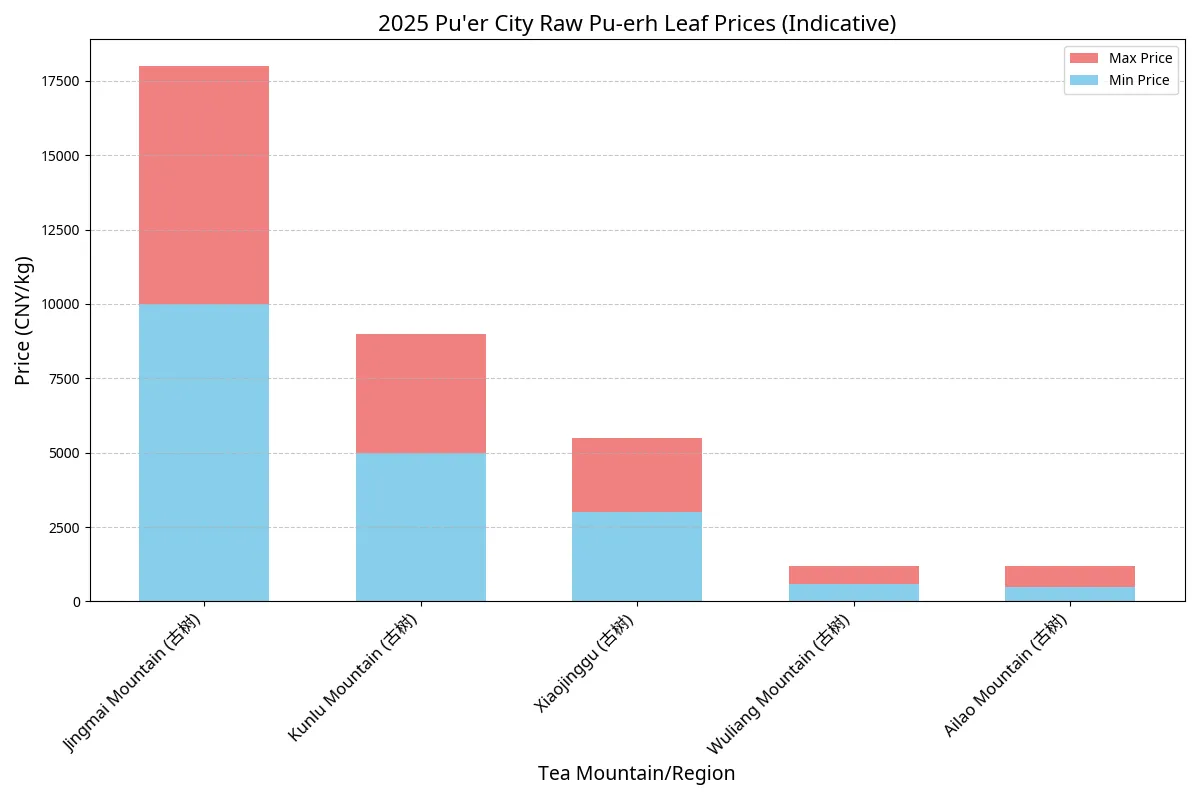2025 Pu'er City Raw Pu-erh Leaf Prices
Analysis of 2025 raw leaf prices for Pu-erh tea from Pu'er City region, covering areas like Jingmai Mountain, Wuliang Mountain, and other significant tea producing areas with market insights.
2025 Pu’er City (普洱市) Raw Pu-erh Leaf Prices
Research into 2025 raw Pu-erh leaf prices for Pu’er City indicates a dynamic market with prices varying significantly based on the tea mountain, the age of the tea trees (ancient tree, big tree, small tree), and specific processing. While comprehensive, structured data is challenging to obtain from publicly available Chinese online sources, several reports and forum discussions provide indicative price ranges for key regions within Pu’er City.
It is important to note that these prices are indicative and can fluctuate based on supply and demand, weather conditions during harvest, and the reputation of specific tea gardens or producers. The data presented below is compiled from various online sources, including news articles, tea forums, and e-commerce listings, and may not represent a complete or definitive market overview.
Indicative 2025 Raw Leaf Prices (per kilogram)
| Tea Mountain/Region | Type of Tea | Indicative Price Range (CNY/kg) | Source/Notes |
|---|---|---|---|
| Jingmai Mountain (景迈山) | Ancient Tree (古树) | 10,000 - 18,000 | Price increase after UNESCO World Heritage status. |
| Spring Tea (春茶) | 128 (for 500g) - 148 (for 500g) | Product listings, likely for general or smaller tree material. | |
| Kunlu Mountain (困鹿山) | Ancient Tree (古树) | 5,000 - 9,000 | General range for ancient tree material. |
| Head Spring Tea (头春茶) | 228 (for 100g) - 980 (for 200g) | Product listings, likely for premium small batches. | |
| Fine Leaf (细叶) | 48,000 | Mentioned as |
a high-end price point. | | Xiaojinggu (小景谷) | Ancient Tree (古树) | 3,000 - 5,500 | General range. | | | Spring Tea (春茶) | 18 (for 500g) - 4,000 (for 500g) | Wide range, indicating different grades/types. | | Wuliang Mountain (无量山) | Ancient Tree (古树) | 600 - 1,200 | General range. | | | Spring Tea (春茶) | 368 (for 1kg) | Product listing for a specific brand. | | Ailao Mountain (哀牢山) | Ancient Tree (古树) | 500 - 1,200 | General range. | | | Spring Tea (春茶) | 89 (for 357g) - 1990 (for 357g) | Wide range, indicating different grades/types. |
Analysis of 2025 Pu-erh Raw Leaf Prices in Pu’er City
The 2025 raw leaf prices in Pu’er City reflect the growing demand for high-quality Pu-erh tea, especially from renowned ancient tea gardens. The significant price range within each region, and even for the same tea mountain, highlights the complexity of the market, influenced by factors such as:
- Terroir and Microclimate: Each mountain and village offers unique growing conditions that impart distinct characteristics to the tea, influencing its value.
- Age of Tea Trees: Ancient tea trees (古树) consistently command the highest prices due to their rarity, deep root systems, and perceived superior quality and cha qi. Large trees (大树) and small trees (小树) or cultivated bushes (台地茶) are priced lower.
- Harvest Season: Spring tea (春茶), particularly early spring tea (头春茶 or 明前茶), is generally the most prized and expensive due to its fresh, vibrant flavor and higher concentration of beneficial compounds.
- Processing and Quality Control: The skill of the tea master in processing the raw leaves (毛茶) significantly impacts the final quality and, consequently, the price.
- Brand and Reputation: Teas from well-known brands or highly reputed tea gardens often fetch higher prices due to established trust and perceived quality.
- Market Speculation and Demand: Pu-erh tea, especially aged Pu-erh, is also an investment commodity, and market speculation can influence raw leaf prices.
Jingmai Mountain continues to see strong price appreciation, particularly after its recognition as a UNESCO World Heritage site. This has further solidified its position as a premium Pu-erh source.
Kunlu Mountain, with its historical status as a tribute tea, maintains high prices for its delicate and fragrant teas, especially the fine leaf varieties.
Prices for Xiaojinggu, Wuliang Mountain, and Ailao Mountain show a broader range, indicating a market with both high-end ancient tree material and more accessible options. These regions offer diverse flavor profiles and are gaining increasing recognition in the Pu-erh market.
Overall, the 2025 market for Pu’er City raw leaf appears robust, with continued strong demand for authentic, high-quality ancient tree material. Consumers and collectors are increasingly discerning, seeking teas with clear provenance and unique characteristics. The online sources, including e-commerce platforms and tea forums, provide valuable, albeit sometimes fragmented, insights into these market dynamics.
2025 Pu’er City Raw Pu-erh Leaf Prices Chart
